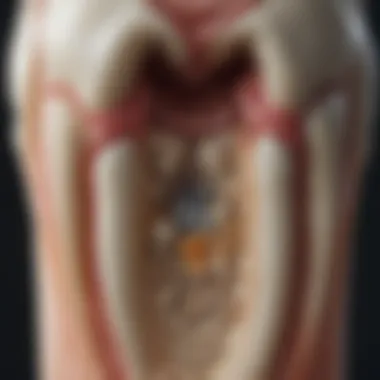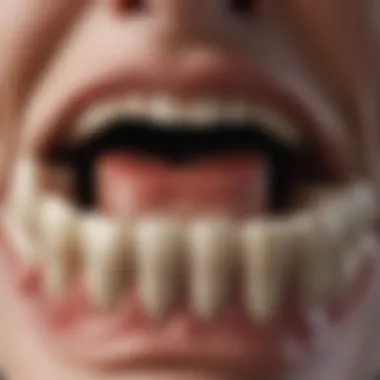Exploring the Intricacies of Teeth Molars: A Comprehensive Guide


Dental Structure: An Intricate World
Teeth molars, often overlooked in everyday discourse, play a significant role in our oral health. While they might seem merely functional in chewing and grinding food, the complexities of their anatomy and functions extend beyond surface-level understanding. This comprehensive guide aims to unravel the mysteries of teeth molars, shedding light on their crucial functions, common issues, and essential maintenance practices.
Unveiling the Anatomy: Beyond the Surface
The anatomy of teeth molars unveils a fascinating landscape of cusps, roots, and enamel. These sturdy teeth, situated at the back of our mouths, are designed to withstand substantial force during the mastication process. Understanding their intricate structure is key to appreciating their resilience and function within the oral cavity.
Functional Significance: Chewing to Health
Beyond their mechanical role in chewing, teeth molars provide essential support for proper digestion and overall health. Their ability to break down food into manageable particles ensures effective nutrient absorption in the digestive system. Delving into the dynamics of this process offers valuable insights into the significance of maintaining healthy molars.
Navigating Common Issues: A Closer Look
Despite their durability, teeth molars are susceptible to various issues, including cavities, cracks, and dental decay. Recognizing the common problems that affect molars is crucial for early intervention and preventive care. This section explores the typical issues encountered with molars and provides guidance on addressing them effectively.
Maintenance Practices: Caring for Your Molars
Proper maintenance practices are fundamental in preserving the health and longevity of teeth molars. From regular brushing and flossing to routine dental check-ups, implementing effective oral hygiene habits is paramount. Discover practical tips and techniques for maintaining optimal molar health and preventing dental complications.
Introduction to Teeth Molars
This pivotal section of the article embarks on unraveling the complexities of teeth molars, offering a profound exploration into their significance within the realm of dental anatomy. Understanding the intricate structures and functions of these molars is crucial in comprehending the nuances of oral health. As the primary tools responsible for chewing and grinding food, molars play a paramount role in maintaining proper digestion and overall well-being. Their interaction with other teeth and impact on facial structure underscores the importance of delving deep into the world of teeth molars.
Understanding Dental Anatomy
Types of Teeth


Delving into the taxonomy of teeth, the categorization betwixt incisors, canines, premolars, and molars unveils the diverse roles each type plays in mastication and speech. Noteworthy is the robust nature of molars, designed for heavy-duty grinding and breaking down of tough substances. Their flat surfaces and numerous cusps make them adept at handling the toughest of food items, ensuring efficient digestion and nutrient absorption. Emphasizing the resilience of molars in chewing challenges, their adaptability in processing various food textures stands out as a commendable trait within the realm of dental anatomy.
Structure of Molars
The intricate architecture of molars reveals a fascinating blend of form and function, reflecting their evolutionary adaptation to the tasks of mastication. The multilayered composition of enamel, dentin, and pulp within molars epitomizes their robustness and durability. This structural complexity enables molars to withstand immense pressure during chewing, highlighting their prowess in maintaining dental integrity. Despite their formidable nature, molars are not impervious to decay and damage, underscoring the importance of meticulous oral hygiene practices to preserve their structural integrity.
Functions of Molars
Chewing and Grinding Food
The fundamental function of molars lies in their adeptness at chewing and grinding food to a digestible consistency. The broad occlusal surfaces of molars facilitate effective breakdown of food particles, ensuring optimal exposure to digestive enzymes. Their strategic positioning in the rear of the oral cavity allows for thorough mastication, enhancing the process of nutrient extraction and digestion. The evolutionary development of molars into specialized grinding tools exemplifies their pivotal role in the intricate process of food breakdown.
Supporting Facial Structure
Beyond their role in processing food, molars play a key function in maintaining the structural integrity of facial features. By exerting pressure on the jawbone during chewing, molars contribute to the stimulation of bone growth and maintenance of jawline definition. This dynamic interplay between molars and facial structure underscores their significance beyond mere masticatory functions, emphasizing their integral role in overall facial aesthetics and structural stability.
Development of Teeth
Eruption Process
The developmental journey of teeth molars unfolds through a fascinating process of eruption, wherein molars gradually ascend from the depths of the jawbone to assume their pivotal roles in the oral cavity. The sequence of molar eruption follows a predetermined pattern, with each molar surfacing at specific stages of dental development. This orchestrated emergence of molars underscores the intricate nature of dental growth and maturation, reflecting the meticulous design inherent in the evolution of teeth.
Formation Stages
At the core of molar development lie the distinct formation stages that culminate in the emergence of fully functional teeth. From bud to cap to bell stages, each phase of molar formation symbolizes a milestone in dental maturation, marking the progressive evolution of teeth molars as essential components of the oral cavity. The intricate interplay of genetic factors, environmental stimuli, and developmental cues orchestrates the precise formation of molars, showcasing the inherent complexity and beauty of dental embryology.
Common Issues with Teeth Molars
In this detailed exploration of the intricacies of teeth molars, it is crucial to address the common issues that can arise. Understanding these issues not only sheds light on potential oral health concerns but also underscores the significance of proactive dental care. By delving into the challenges faced by teeth molars, individuals can proactively safeguard their oral well-being through informed decisions and preventative measures.


Cavities and Decay
Causes of Decay
Delving into the specific aspect of causes of decay is essential in comprehending the vulnerabilities that teeth molars can encounter. These factors contribute significantly to overall oral health and play a critical role in maintaining the integrity of molars. Highlighting the primary causes of decay elucidates the risk factors associated with poor oral hygiene and dietary habits. Exploring the nuances of decay causation not only educates individuals but also empowers them to make informed choices for optimal dental health.
Preventive Measures
Examining preventive measures in the context of teeth molars is paramount for mitigating the risk of decay and sustaining oral well-being. These measures serve as a proactive approach to dental care, emphasizing the importance of regular oral hygiene practices and professional interventions. By emphasizing preventive strategies, individuals can adopt habits that promote long-term dental health and minimize the incidence of decay. Understanding the preventive measures tailored for teeth molars equips individuals with the knowledge to preserve their oral health effectively.
Impacted Molars
Exploring the realm of impacted molars provides valuable insights into the challenges that individuals may face. From identifying symptoms to seeking appropriate treatment options, understanding the implications of impacted molars is integral to holistic dental care. By examining the symptoms associated with impacted molars, individuals can recognize potential issues early on and address them proactively. Moreover, exploring various treatment options offers individuals a comprehensive view of the therapeutic interventions available, fostering informed decision-making for optimal oral health outcomes.
Bruxism and Grinding
Addressing the effects of bruxism and grinding on molars illuminates the intricate relationship between dental health and habitual behaviors. By outlining the repercussions of these habits on molars, individuals gain insight into the potential consequences and risks involved. Moreover, exploring management techniques for bruxism and grinding elucidates the preventive strategies and interventions that can mitigate adverse effects on molars. Understanding the interplay between bruxism, grinding, and molar health empowers individuals to take proactive steps towards preserving their dental well-being.
Maintaining Healthy Teeth Molars
Maintaining Healthy Teeth Molars is a critical aspect of oral health that often gets overlooked but plays a crucial role in overall well-being. From preventing cavities to promoting proper chewing function, the care of teeth molars is indispensable. By adopting good dental habits, individuals can ensure the longevity and functionality of their molars. Regular maintenance not only safeguards against tooth decay but also contributes to a confident smile and comfortable eating experience.
Dental Care Practices
Brushing Techniques
Brushing Techniques are at the forefront of maintaining healthy teeth molars, as they remove plaque and food particles that can lead to decay. The key to effective brushing lies in using a soft-bristled toothbrush with fluoride toothpaste in gentle circular motions to cover all tooth surfaces thoroughly. This technique ensures complete cleaning without damaging the enamel. Brushing after meals and before bedtime is advisable to maintain optimal oral hygiene. While manual toothbrushes are economical and widely used, electric toothbrushes offer the advantage of deeper cleaning and better plaque removal.
Flossing Tips


When it comes to dental care, Flossing Tips complement brushing by reaching areas between teeth that a toothbrush cannot access. Flossing helps remove plaque and debris, reducing the risk of gum disease and cavities. Using a gentle back-and-forth motion, individuals should carefully floss once a day to keep their teeth and gums healthy. While traditional string floss is effective, floss picks provide a convenient alternative for on-the-go oral hygiene.
Regular Dental Check-ups
Importance of Check-ups
Regular Dental Check-ups are essential for monitoring oral health and addressing any issues promptly. Early detection of dental problems such as cavities or gum disease can prevent complications and costly treatments. Dental professionals also perform thorough cleanings during check-ups, ensuring a deep cleanse that complements daily oral care routines. Attending routine check-ups allows for proactive management of dental issues before they escalate.
Frequency Recommendations
The Frequency Recommendations for dental check-ups typically range from every six months to once a year, depending on individual oral health needs. Those prone to dental issues may benefit from more frequent visits to maintain optimal oral health. Establishing a regular dental check-up schedule with a trusted dentist promotes preventive care and serves as a proactive approach to long-term oral well-being.
Dietary Considerations
Impact of Diet on Molars
The Impact of Diet on Molars cannot be overstated, as the foods consumed directly influence oral health. Sugary and acidic foods can erode enamel and contribute to tooth decay, while calcium-rich foods and crunchy fruits and vegetables promote dental health. Implementing a balanced diet that supports oral health strengthens teeth and gums, reducing the risk of cavities and other dental problems.
Healthy Eating Habits
Practicing Healthy Eating Habits is key to maintaining healthy teeth molars. Consuming a variety of nutrient-rich foods, staying hydrated, and limiting sugar intake are fundamental aspects of a tooth-friendly diet. Additionally, incorporating foods high in calcium and vitamin D supports strong teeth and bones. By making conscious dietary choices, individuals can enhance their oral health and preserve the integrity of their teeth for years to come.
Conclusion
Teeth molars, an essential component of our dental anatomy, hold paramount importance in maintaining optimal oral health. Throughout this detailed guide on the intricacies of teeth molars, we have unveiled the critical role these teeth play in functions such as chewing and supporting facial structure. Understanding the anatomy and functions of molars equips individuals with the knowledge necessary to recognize and address common issues like cavities, decay, impacted molars, and bruxism. By delving into the developmental stages and eruption process of molars, we gain a profound appreciation for the complexity of dental growth and maintenance.
Summarizing Molar Care
Key Takeaways
Key takeaways from this guide encompass the necessity of proper dental care practices in ensuring the health and longevity of teeth molars. Emphasizing brushing techniques and flossing tips, this section underscores the importance of regular dental check-ups in detecting and preventing potential issues early on. By embracing healthy dietary considerations, individuals can significantly impact the well-being of their molars, recognizing the intricate relationship between diet and oral health. The meticulous attention to molar care highlighted in this article serves as a foundational pillar in promoting overall dental wellness.
Future Prospects
As we envision the future prospects concerning teeth molars, the integration of advanced technology and research promises revolutionary developments in dental care. The continuous advancement in preventive measures and treatment options for common molar issues heralds a promising era in oral health. With a growing emphasis on personalized dental care, tailored to individual needs and genetic predispositions, the future augurs well for enhanced molar care strategies. By staying informed and proactive in embracing evolving trends in dental health, individuals can look forward to a future where molar care is optimized, leading to improved overall oral health outcomes.







